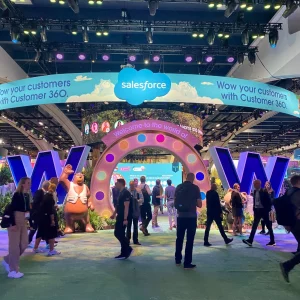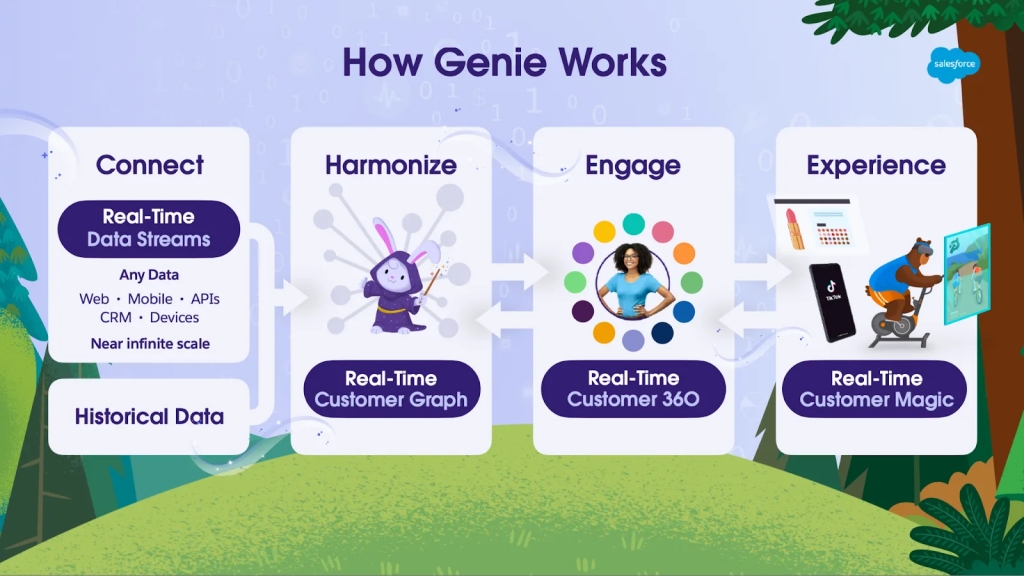
After a COVID-induced hiatus, Dreamforce was back at Moscone in San Francisco last week. Salesforce brought all of the usual marketing glitz and glamour—including the national-park Trailblazer theme, Hawaiian blessings, Salesforce product mascots, puppies, a star-studded lineup of celebrities and luminaries, and a Red Hot Chili Peppers concert—to this reunion event. 40,000 attendees participated in-person, and another 110,000 tuned in virtually via Salesforce+.
As usual, the vendor also unleashed a tsunami of new product announcements. As always, it takes a while for the dust to settle after the Dreamforce tsunami. But here are some of the announcements that rose to the top for me, and my initial thoughts on them.
Salesforce’s Genie is Out of the Bottle, But Questions Remain
The event headliner was Salesforce Genie, which is a hyperscale, real-time customer data platform that runs on AWS. According to Salesforce, “Genie ingests and stores real-time data streams at a massive scale and combines it with Salesforce transactional data.” Using Genie’s pre-built connectors, companies can bring in data from different applications, devices, and systems to get a unified view of each customer—allowing them to create more personalized experiences. In a nutshell, Genie is designed to help companies that have customer data in many different applications get a more holistic view of each customer.
While Salesforce and other vendors have espoused the importance of an integrated, 360-degree customer view for years, Genie does this in real-time—supposedly as fast as in milliseconds. Genie uses Salesforce’s metadata model, to make Genie data available across all of the Salesforce clouds, and brings new capabilities to Einstein AI and Flow automation solutions. For instance, using real-time data from Genie, Einstein can deliver more personalized and relevant predictions, and Flow can use this data to automatically trigger actions. 18 AppExchange partners have already integrated with Genie as well.
During the analyst Q&A, Salesforce execs were peppered with questions about Genie pricing and packaging. While Genie is available now, it sounds like pricing is a work in progress, as Salesforce tests a variety of different consumption models, based on factors such as the number of customer profiles, engagement segments and events, and other parameters.
Salesforce used Genie to power the Dreamforce experience and showcased some very large customers, such as Ford and L’Oreal , that are using Genie with some very impressive results. But other customers are still trying to wrap their heads around it. Two Salesforce MVP customers (one a small non-profit, and the other a 15,000-employee software company) that I spoke with both felt that while the concept sounds great, they will need a lot more guidance to understand how they’d actually implement it in their companies.
Slack Turbo Charges Collaboration

Declaring that “It’s a new day for work,” Tamar Yehoshua, chief product officer for Slack, unveiled updates to Huddles and a new offering, Slack Canvas. Huddles, which has to date only supported audio, has added support for lightweight video, as well as multi-person screen sharing and message threads, which Salesforce is rolling out now.
Slack Canvas is slated for availability next year. It integrates Quip functionality to provide users with one, persistent place to capture, share and take action on information. Canvas can bring in data from multiple systems, and save it in one place, either as a personal information store or attached to a channel. One of the most helpful things here is that Canvas will permanently record all information, making it easier for users to find what they need more quickly.
These enhancements help extend Salesforce’s paradigm for the Digital HQ, making it easier for people to collaborate across remote, in-office, and hybrid work locations, and more flexible work schedules as the future of work continues to evolve.
Salesforce Resets the Easy Button for SMBs
In 1999, Salesforce launched as a revolutionary, cloud-based CRM solution for small and medium businesses (SMBs). But as cloud technology matured, and the benefits of cloud software become readily apparent, Salesforce become the major CRM vendor for large enterprises. As Salesforce focused more on the needs of larger companies, its solutions become more complex and expensive, and too unwieldy for many smaller companies to access and use.
Over the years, Salesforce has made several attempts to get back to its small business roots, with solutions such as Desk.com, SalesforceIQ, and most recently, Salesforce Essentials. But none of these really took off. So Salesforce went back to the drawing board, and this time, it has come up with Salesforce Easy.
Designed for companies or teams with 25 or fewer users, Easy aims to deliver a streamlined and simplified experience for customers to try, buy and extend their use of Salesforce as needed. Built on core Salesforce technology, it brings sales, service, and marketing tools together in one application, priced at $25 per user per month for an annual contract. Easy features a self-service, e-commerce buying experience, and a three-click setup, and provides templated, best practices, out-of-the-box dashboards, and in-app, contextual support.
While Easy shares many of the aspirations of Essentials, it aims to provide a more comprehensive and intuitive approach. For instance, marketing functionality was sorely lacking in Essentials. Easy includes some basic email marketing functionality now, and Salesforce intends to add more robust functionality once Marketing Cloud is running on the core Salesforce platform. The vendor also plans to add e-commerce, analytics, quoting, custom objects and advanced forecasted functionality to Easy, although specific timing for these is still TBD.
Meanwhile, although no plans to shutter Essentials have been announced, my guess is that Salesforce will start to funnel Essentials trials and prospects to Easy within the next couple of quarters.
Easy’s launch has been very quiet by Salesforce standards. According to Kris Billmaier, SVP and GM for the solution, this has been by design. To date, the team has relied on organic search and SEO to build its customer base, so it can learn more about customer buying and solution preferences, and evolve Easy accordingly before making a major marketing push. With so many strong competitors in the SMB CRM space, this is a wise decision. Hopefully, the Easy team is learning from past efforts, is paying close attention to customer and prospect feedback, and will be able to field a more competitive solution this time around.
Net Zero Marketplace for Carbon Credits
Salesforce and CEO and Founder Marc Benioff have long advocated for environmental concerns. At Dreamforce, the vendor introduced Net Zero Marketplace, a platform for carbon credit purchases. Built on Salesforce’s Commerce Cloud, it enables buyers to easily buy carbon credits from vetted ecopreneurs. The site also provides education about climate issues and other, more substantive steps that companies can take to reduce their carbon footprints.
Net Zero Marketplace debuts with about 90 projects across 11 countries throughout the world. It provides buyers with project descriptions, details about how they align with UN Sustainable Development Goals, and third-party ratings.
Any organization or individual can use the Net Zero Marketplace to buy carbon credits. The Marketplace also integrates with Salesforce’s Net Zero Cloud carbon accounting solution, which helps companies manage sustainability data, automate supplier emissions tracking, and forecast and reduce risk. Net Zero Marketplace will be available in the U.S. starting in October 2022, with expansion to additional markets slated for 2023.
Demand for carbon credits is growing, but the path to purchasing them can be confusing for smaller companies. Salesforce’s Net Zero gives these companies a trusted and transparent way to buy them, and provides actionable information about other avenues they can pursue to create more environmentally sustainable businesses. It should also motivate innovation among ecopreneurs to create more and higher quality carbon offset alternatives.
Salesforce Customers Go with the Flow
Salesforce Flow is a low-code platform that enables people to automate complex business processes. Basically, Flow applications collect data and then trigger appropriate actions—think reminders, emails, notifications, etc.–based on that data. Flow Builder enables non-coders to build these automations without having to use a programming interface.
At Dreamforce, Salesforce revealed that 44 billion Flow automations are run every day. According to the vendor, this saves organizations 100 billion hours of work every month that would they would have had to put in to manually complete these tasks. Salesforce estimates that this adds up to $2 trillion in customer value.
Looking ahead, the use of Flow and other low-code and no-code platforms will grow even faster, as companies continue to struggle with the tech talent shortage, and the need to develop new, more streamlined processes to meet both internal and customer needs.
Guided by the Beginner’s Mind
Ok, this one isn’t a product announcement. But I think that it speaks volumes about Salesforce–and its ability to stay ahead of the very fast pace of change in the technology industry.
In the keynote, Benioff articulated that the driving force behind this relentless push to the future rests on constantly rethinking the way people work. Referring to the fact that the COVID-19 pandemic has and will continue to change the world, he talked about the Japanese concept of shoshin, which means the beginner’s mind. He stated that “We need to have a beginner’s mind, especially when it’s a new day like this. A beginner’s mind has every possibility, but the expert’s mind has very few.” While many companies get stuck in the innovator’s dilemma, Benioff is determined to explore all possibilities.
It’s too early to tell exactly how all of the new products announced at Dreamforce will play out in the market. But the beginner’s mind has served Salesforce well to date, and it’s a good bet that Salesforce it will continue to guide it well in these new endeavors.
© SMB Group, 2022
Source: Laurie McCabe’s Blog





